Are you a Quiet Speculation member?
If not, now is a perfect time to join up! Our powerful tools, breaking-news analysis, and exclusive Discord channel will make sure you stay up to date and ahead of the curve.
Last week, an old Magic buddy texted me out of the blue, asking if I was interested in going to SCG Baltimore at the end of the month to play some live Modern. My first reaction: “Can’t do it, I’ve got way too much going on…” But then I remembered that it’s summer, and I have next to no responsibilities!
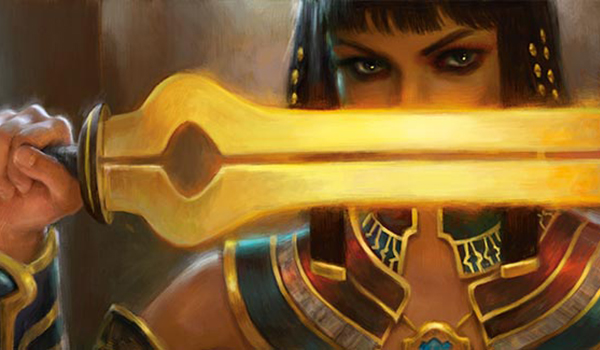
Once it was established that I was probably going to go, our follow-up conversation went something like this:
Me: "We’re going. Sweet, now what are we going to play?"
Him: "I always play Jund, year after year, no matter what. I know next to nothing about what my opponents are doing."
Me: "Welp."
I figured this week was as good a time as any to talk about event preparation in general, and specifically give some insight into my work leading up to Baltimore, which is currently in its beginning stages. Next week might serve as a follow-up to our discussion here, but for now, my goal is to provide an introduction to event preparation strategies in general, while also providing solid information about Modern as it stands halfway through May 2017. The hope here is that there's something for everyone: those looking to play in a large-ish event at any point in the future, and those interested in winning in Modern at all levels right now. Hopefully you fall into one of those camps; if not, I suggest reading a finance article or something.
As a brief reminder, from here on I'll be referring to MTGO metagame information and basing my analysis and speculation on that data. I'm exclusively an online player, and when it comes to predicting metagame trends, I've had the most success looking at online data, coupling it with my own experiences, and then translating that info to the paper world. Usually, you can expect the MTGO metagame to move roughly a couple weeks ahead of the paper metagame. It's also often the best window into the pro community's take on the format—not too many pros show up to IQs or local paper tournaments, but you'll find plenty of known usernames in the 5-0 League finishes.
Hopefully that provides some context for why I value MTGO results so highly. Onwards!
Step 1: Lay Out Your “Knowns”
 The first step in event preparation is listing all the information available to you at Level 0. As everything we do from here will undoubtedly be tied both to information and speculation from this point, having a visual guide to the “knowns” will help us from straying too far down the rabbit hole, keep us on track, and give us a clear goal to work for. Here’s my list of knowns, two weeks ahead of Baltimore.
The first step in event preparation is listing all the information available to you at Level 0. As everything we do from here will undoubtedly be tied both to information and speculation from this point, having a visual guide to the “knowns” will help us from straying too far down the rabbit hole, keep us on track, and give us a clear goal to work for. Here’s my list of knowns, two weeks ahead of Baltimore.
Time (10 days). As I’m writing this on Tuesday, I’ve got a little over a week to prepare for the event. Realistically, given other commitments and things going on (getting back from vacation, then starting a new job next week), I’m expecting I’ll be able to devote around 10 hours to event prep at most, spread out in evenings over a week-long period. Outlining how much time you have to work, and thinking about said time both quantitatively and qualitatively (when you’ll be able to work) is essential to event prep. Will we be able to start from “square one” and approach the format from a macro-level, with the ability to devote time and energy to multiple archetypes? Or will we have to concentrate our time on one specific archetype, focusing instead on tuning and matchup practice?
Card Pool. Do you have access to any deck, if necessary? Slightly less important than time, card pool also influences the subsequent decisions we’ll be making. I’ve experienced both extremes, going from having access to virtually every card/deck in the format, to the point I’m at now, where all the cards I own are virtual. I’ll undoubtedly be borrowing cards from various friends/contacts, but I’ll have to test with the knowledge in mind that my first, second, or even third option for final build might not be available to me.
Prior Knowledge. This holds true across all formats, but is especially true for eternal formats like Modern and Legacy: archetype familiarity often trumps right deck for the field. Modern rewards intricate knowledge of deck strategy, sequencing, sideboarding, and understanding of roles, more so than Standard and Limited. Tron might be the best deck in the field, but if I’ve never played a match of Tron in my life, and am well-versed in the ins and outs of Ad Nauseam, I’ll need to take a hard look at what the best use of my time is.
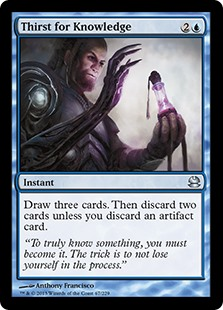 Time and prior knowledge are closely tied, to the point where they should probably be equal on this list. In an ideal world, we’d love to be able to systematically work through our initial format assumptions, proving and disproving, moving closer to the final result with each game played. In reality, we never have enough time to do all the exploring we’d like to do, and some leads result in dead ends, or even backward steps as we spend time tuning archetypes that we later find fall short. It’s no secret that the best-performing players have ways of beating father time, be they teams, Facebook information groups, or sources of expertise that they can rely on to point them in the right direction or specialize the work.
Time and prior knowledge are closely tied, to the point where they should probably be equal on this list. In an ideal world, we’d love to be able to systematically work through our initial format assumptions, proving and disproving, moving closer to the final result with each game played. In reality, we never have enough time to do all the exploring we’d like to do, and some leads result in dead ends, or even backward steps as we spend time tuning archetypes that we later find fall short. It’s no secret that the best-performing players have ways of beating father time, be they teams, Facebook information groups, or sources of expertise that they can rely on to point them in the right direction or specialize the work.
So, let’s lay out where we’re at. Ten days away from SCG Baltimore, MTGGoldfish pegs the top decks as Affinity, Storm, Eldrazi Tron, and Death’s Shadow, with a variety of decks grouped slightly lower in representation below them. Looking back a couple weeks, Dredge has dropped out of the top tier it once occupied, to be replaced by Storm; Death’s Shadow is the most played archetype, though its numbers are split between traditional and Grixis variants. Recently, I’ve had experience piloting various UWx strategies, and both Shadow variants, and I’m well-versed in Burn, Jund, and Abzan. Beyond that, it’s uncharted territory.
Step 2: Define Targets, Narrow Choices
Taking in what we know—prior knowledge, time constraints, and available card pool—our next step is to translate that information into something manageable that takes into account our unique situation. The best way to filter information is to break it into smaller chunks, and refine from there, starting with macro-archetype.
Here is the macro aggro/combo/control breakdown as I see it, among the 13 most represented archetypes on MTGO.
- Aggro: 25%
- Combo: 18.5%
- Midrange: 13.6%
MTGGoldfish metagame numbers are weird, because all archetypes are weighted equally. Any deck that puts up a 5-0 finish grabs a piece of the pie, so you tend to see a larger split than conventional paper metagame breakdowns. Click the "load more" button a few times and you'll see 40 archetypes represented sometimes, often among them duplicates of some top decks but with a different name, or with a single odd card choice the site's formula doesn't seem to like. So, take those numbers with a grain of salt, but for the most part recognize that they are at least slightly accurate, and have some use to us.
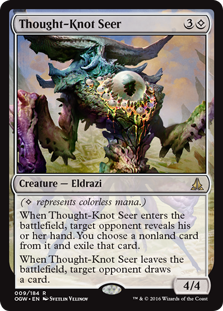 What’s immediately apparent to me is Eldrazi Tron’s identity in the field not as a ramp-combo deck, as normal Tron decks would be classified, but as midrange. With Jund falling out of the higher-curve end of deck representation, thanks in large part to Eldrazi Tron, it appears that Tron itself has taken on the role of midrange, thanks to its variety of threats and ability to compete well into the lategame with its card advantage and pricey spells. Dredge essentially swapped places with Storm, and while it might seem like focusing on Storm would be a good place to start, we would do well not to forget that just two weeks ago Dredge occupied Storm’s slot. Focusing on one at the expense of another will just result in Dredge creeping back up into the top tier, as the deck has certainly demonstrated its pedigree at this point.
What’s immediately apparent to me is Eldrazi Tron’s identity in the field not as a ramp-combo deck, as normal Tron decks would be classified, but as midrange. With Jund falling out of the higher-curve end of deck representation, thanks in large part to Eldrazi Tron, it appears that Tron itself has taken on the role of midrange, thanks to its variety of threats and ability to compete well into the lategame with its card advantage and pricey spells. Dredge essentially swapped places with Storm, and while it might seem like focusing on Storm would be a good place to start, we would do well not to forget that just two weeks ago Dredge occupied Storm’s slot. Focusing on one at the expense of another will just result in Dredge creeping back up into the top tier, as the deck has certainly demonstrated its pedigree at this point.
Another point of interest is the lack of a true control deck among the top options. UW has taken over where Jeskai and Grixis used to roam, but 2% of the metagame is nowhere near enough to make a significant impact. This, to me, suggests two possibilities. The first is that the format is hostile to control, and the deck cannot hope to succeed in a field apparently detrimental to its survival. The second is the opposite—with no control deck making any impact on the format, its possible that other decks have ignored it in terms of preparation and construction, and the field might be ripe for control to come in and make an impact.
Step 3: Look at Individual Decks
Once we’ve gained an understanding of the macro archetypes at work in the format, the next step is to highlight strengths and weaknesses of particular archetypes to determine their viability come event time. We do this not just to figure out what we should be playing ourselves, but to speculate on what other players will be doing as well. Affinity might be one of the most played archetypes right now, but if it can’t beat a clear enemy, and most players know that, the field might decide in large numbers not to bring Affinity to event day. This is one of many variables that can influence disparity between what we see in the statistics compared to the actual day-of metagame. I’ve already done a bit of exploring here, but will continue to do so over the coming days. Here are my initial impressions of some of the top decks in the format.
Affinity
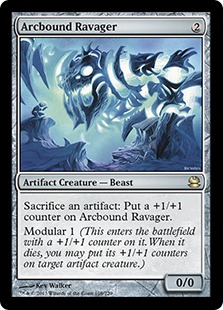 Affinity is well-positioned to capitalize on a field where the best aggro deck doesn’t play a creature on turn one. Thoughtseize and discard are poor against a strategy that dumps its hand on turn two, as is a cavalier approach to one’s life total. Both are core tenets of Death’s Shadow, the deck on everyone’s radar. While the rest of the format continues to warp itself around Fatal Push, Affinity is playing the same list from years ago, with only a few minor changes. It still dies to Stony Silence, but that doesn’t matter, as Stony Silence and Affinity have existed side by side for years and the deck continues to be a staple of the top tables.
Affinity is well-positioned to capitalize on a field where the best aggro deck doesn’t play a creature on turn one. Thoughtseize and discard are poor against a strategy that dumps its hand on turn two, as is a cavalier approach to one’s life total. Both are core tenets of Death’s Shadow, the deck on everyone’s radar. While the rest of the format continues to warp itself around Fatal Push, Affinity is playing the same list from years ago, with only a few minor changes. It still dies to Stony Silence, but that doesn’t matter, as Stony Silence and Affinity have existed side by side for years and the deck continues to be a staple of the top tables.
Storm
Dropping Pyromancer Ascension and adding Gifts Ungiven, as well as another Goblin Electromancer in the form of Baral, Chief of Compliance, has contributed into Storm’s ascension (heh) to the top decks in the field. Previously, a couple discard spells was all it took to take this strategy down, and it rarely managed to untap with Electromancer and go off. Now, a higher land count and the addition of Gifts Ungiven has Storm well-prepared to go into the midgame against any opponent, and any turn could be your last against this deck, whether they have something on the board or not.
Eldrazi Tron
Bant Eldrazi has largely been replaced by colorless Eldrazi Tron, which combines the best of both the old Eldrazi and RG Tron lists into a streamlined powerhouse that plays both sides of the curve well. Basilisk Collar on Walking Ballista handles most of the creature decks in the format, and even with Eye of Ugin banned, the deck still gets to do crazy things with its manabase and undercosted threats. Matter Reshaper, Thought-Knot Seer, and Reality Smasher are assuredly to blame for the deck’s success, as each are packed with as much power, toughness, and incidental value that Wizards’ could possibly fit into the design template. No wonder the deck is so strong.
Death’s Shadow Aggro
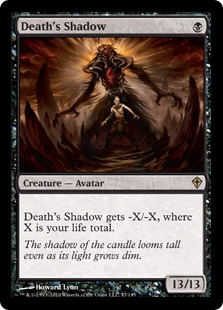 This deck packs more value and punch into undercosted spells than anything I’ve seen in the format since Dig Through Time. Death's Shadow, as long as you cut the chaff and don’t mind being patient, can be played alongside a number of other powerful spells as basically the black Tarmogoyf. Death’s Shadow Aggro does what Jund or Little Kid Abzan never could: present a consistent, powerful clock without sacrificing card quality.
This deck packs more value and punch into undercosted spells than anything I’ve seen in the format since Dig Through Time. Death's Shadow, as long as you cut the chaff and don’t mind being patient, can be played alongside a number of other powerful spells as basically the black Tarmogoyf. Death’s Shadow Aggro does what Jund or Little Kid Abzan never could: present a consistent, powerful clock without sacrificing card quality.
The deck takes advantage of a number of powerful synergies while not overly relying on any one in particular, and gets to play Death's Shadow, in my opinion the most individually powerful card in the format. The fact that the card has spawned multiple decks around it, the fact that it tends to be those decks' namesake, and the (granted, premature) discussion of its possible banning all contribute to my belief that Death's Shadow is running the format right now. No other non-combo card in Modern threatens victory more quickly than this card, and its play is primarily responsible for a decrease in play of Lightning Bolt, the previous so-called king of Modern. Death's Shadow has been around for years, but he’s finally found the right home.
Burn
Burn has benefited greatly from all the recent changes to the format. Jeskai Control’s demise is a welcome sight, as is the rise of Death’s Shadow and Storm’s interest in slowing down its gameplan. Burn's only natural enemy is Dredge (depending on who you talk to, Affinity can be tough as well), but for the most part, Burn is well-positioned to attack a format that is largely ignoring it. Maindeck lifegain in the form of Basilisk Collar is never pretty, but for the most part, I see a field with plenty of solid matchups and not many poor ones.
Knightfall
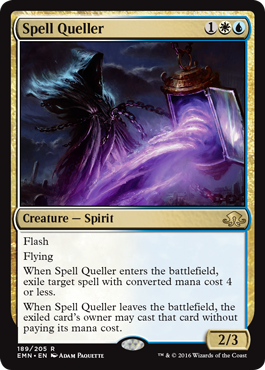 As was prophesied with the printing of Spell Queller, Knightfall has been able to incorporate a few new printings not necessarily “meant” for the archetype, into a shell that has quietly been putting up an increasing number of strong finishes online. At first glance, it seems this is due more to the characteristics of the format than to the individual merits of the archetype itself, but it’s difficult to argue with what the deck brings to the table. A fast, proactive gameplan, individually powerful spells, the ability to switch roles if necessary, and great sideboard spells in all the right colors is a recipe for success. I’m definitely intrigued.
As was prophesied with the printing of Spell Queller, Knightfall has been able to incorporate a few new printings not necessarily “meant” for the archetype, into a shell that has quietly been putting up an increasing number of strong finishes online. At first glance, it seems this is due more to the characteristics of the format than to the individual merits of the archetype itself, but it’s difficult to argue with what the deck brings to the table. A fast, proactive gameplan, individually powerful spells, the ability to switch roles if necessary, and great sideboard spells in all the right colors is a recipe for success. I’m definitely intrigued.
Dredge
It happened more slowly than I expected, but players finally came around to the notion that Dredge is not gone for good, and will continue to put up results if not respected. For now, it looks like the field recognizes the aggro-combo deck’s threat, but as we’ve seen time and again with Affinity, everyone loves to cheat. What Dredge does and how to beat it are clearly known at this point, but who knows what story Baltimore will tell?
Abzan
Jund’s surprising disappearance has left Abzan the format's de-facto reigning midrange deck, depending on how you feel about Eldrazi Tron. Lingering Souls, some maindeck lifegain, and not having to rely on Lightning Bolt are all strong draws to the archetype. The ability to play better sideboard spells is another solid strength it can claim. I’ve wanted to sit down and explore this deck in depth for a bit now, and while I don’t want to speak too soon, I wouldn’t be surprised if my initial impressions about the format lead me down the Abzan road in the next couple of days.
Conclusion
We’re getting a little long here, so for now I think we’ll bring this article to a close. We can build upon this framework next week, on the eve of SCG Baltimore. I currently plan on attending, but card availability and travel costs might prove an issue. If so, I’ll definitely be at Charlotte in early June, and I’m looking forward to backing up all this theory with some strong results, or at least an interesting report.
Let me know what you think in the comments, about the article and the format as a whole. What are your impressions about the field ahead of the event, and what do you expect to see happen on Saturday? Thanks for reading, and I’ll see you next week.



